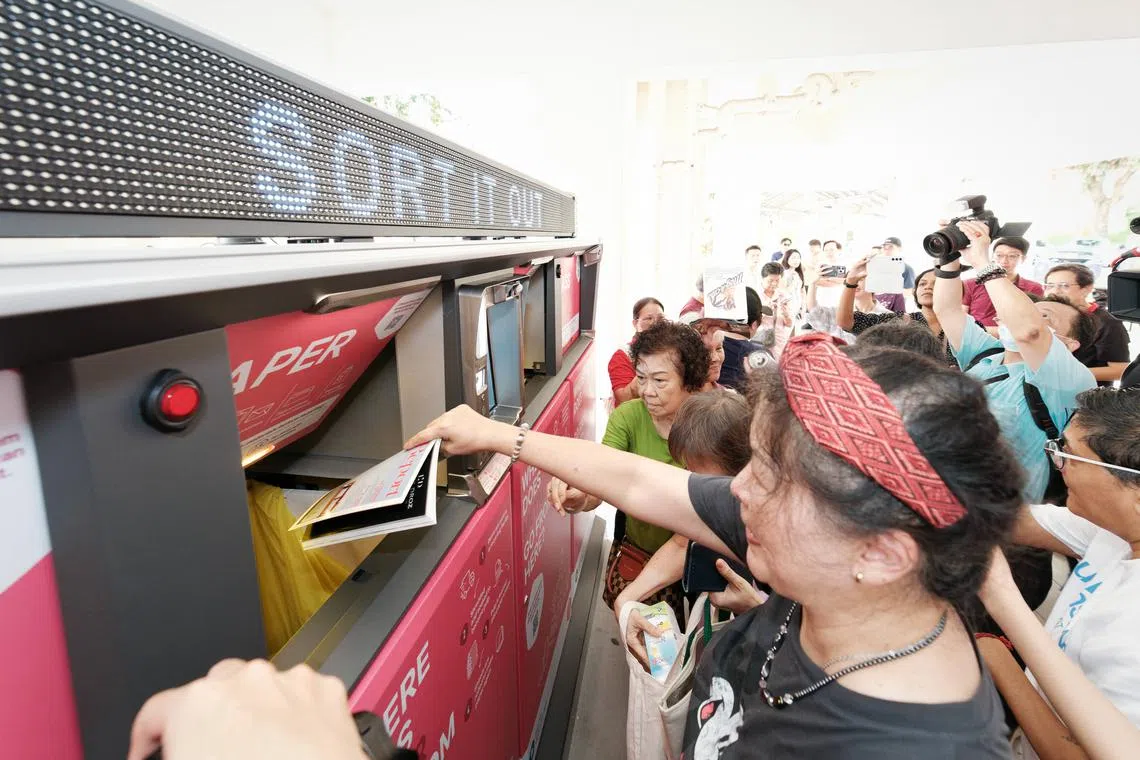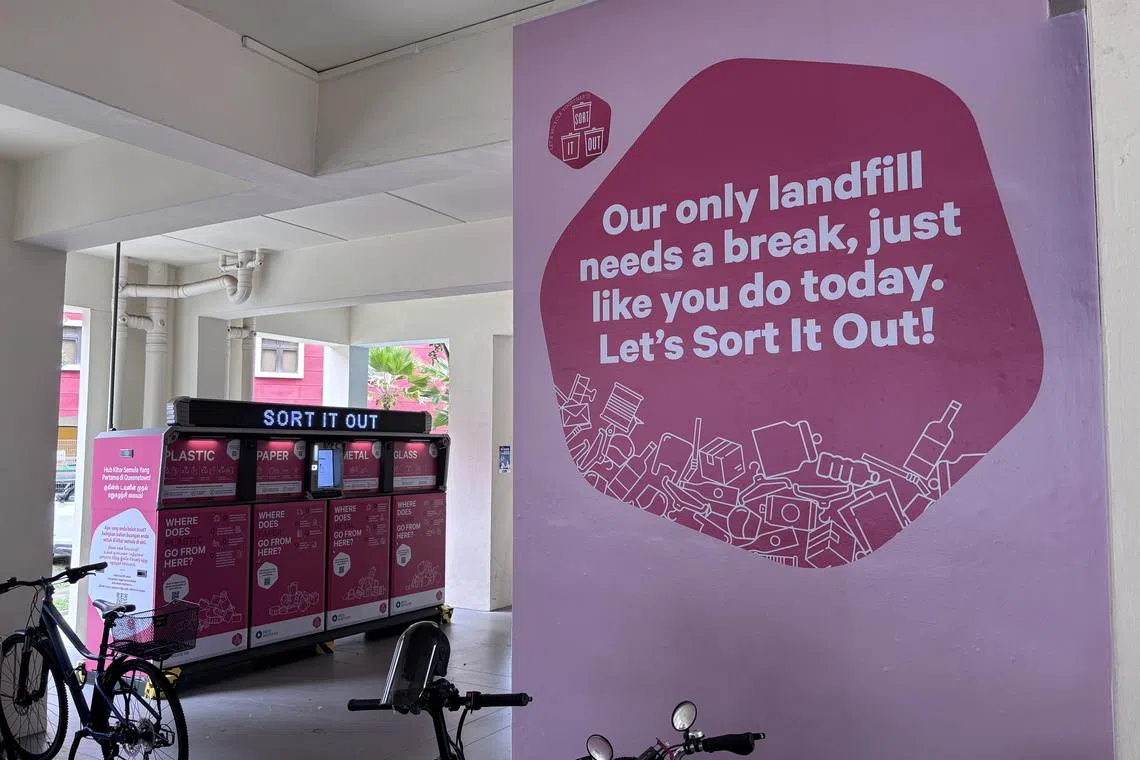Segregated recycling bins found to lower contamination rate as more spring up
Sign up now: Get ST's newsletters delivered to your inbox

Zero Waste SG told ST that its first recycling hub, launched in June in Queenstown, has shown promising results so far.
PHOTO: ZERO WASTE SG
Follow topic:
- Segregated recycling systems reduce contamination rates significantly. Zero Waste SG's hub shows below 5% contamination to date.
- More segregated recycling points are emerging across Singapore, offering an alternative to mixed recycling in blue bins at public housing.
- Segregated recycling channels could be an effective way to improve recycling in Singapore, if the cost of logistics can be contained, says one non-profit.
AI generated
SINGAPORE – Segregation of recyclables can drastically curb contamination, which has contributed to Singapore’s low recycling rates for years, non-governmental organisation Zero Waste SG has found.
The finding comes as nearly 40 more locations for segregated recycling bins were added across the island since 2024. They provide an alternative to the blue recycling bins at the foot of every public housing block, where recycled metal, glass, plastic and paper are mixed and collected for sorting in facilities.
Zero Waste SG, a charity that advocates waste reduction, told The Straits Times that its first recycling hub launched in June in Queenstown has shown promising results so far, with a contamination rate of less than 5 per cent.
This is a far cry from the persistently high contamination rate of about 40 per cent
Contaminated recyclables are incinerated.
Local waste company 800 Super, which is behind most of the new recycling points, previously said a two-year trial in Bishan and Sin Ming that ended in 2024 showed that segregated infrastructure could help cut contamination rate of recyclables to just 10 per cent.
800 Super is one of three public waste collectors appointed by the National Environment Agency to collect recyclables from residential areas.
Zero Waste SG executive director Lionel Dorai said that through advocacy and providing infrastructure, the charity hopes to understand whether households here can acquire the habit of sorting their waste and disposing of them correctly in segregated recycling systems.
Waste segregation has long been practised by people in countries like Japan, South Korea and Australia, but challenges posed by Singapore’s infrastructure and people have hampered its adoption here, according to the group’s studies.
Mr Dorai said barriers mentioned by residents include lack of support from peers, as well as the perceived effort and inconvenience of sorting.
“Residents cited that the change in habit would inconvenience them, as the current convenience of the chute infrastructure is an engrained habit since young,” he said.
He added that some residents also said they are not confident in the current recycling infrastructure because of overflowing bins, low collection frequencies and lack of transparency about what happens after collection.
Despite the challenges, there appears to be some interest, with Zero Waste SG collecting about 300kg of clean recyclables at its Queenstown hub in the three weeks before its official launch.
The recycling station is equipped with sensors that trigger alerts when any of the bins reach 80 per cent capacity, and is handled by public waste collector SembWaste’s network of recycling service providers.
Mr Dorai said the team will track the performance of the Queenstown hub and a second point set up in Pioneer on July 5, before releasing its results and deciding whether to roll out more.
Meanwhile, 800 Super said it has likewise seen “encouraging results” from “mostly clean recyclables collected” in its smart recycling boxes that have a segregated system.
The company first trialled the system, which collects paper, plastic, aluminium, glass, metal cans and clothing in separate compartments, at 10 locations in Bishan East-Sin Ming in April 2022.
The system awards points via an app to residents for depositing these items. By July 7, 2025, there were more than 5,900 registered users, more than double the number of users as at May 2024.

Despite the challenges, there appears to be some interest, with Zero Waste SG collecting about 300kg of clean recyclables at its Queenstown hub in the three weeks before its official launch.
PHOTO: ZERO WASTE SG
So far, the boxes are operating at 47 locations, most of which can be found in Ang Mo Kio.
About 20,000kg of recyclables were collected from these boxes in May through the system, a spokeswoman told ST on July 7, but declined to share their contamination rate. She said the company aims to reach a total of 93 locations by October 2025 in its Ang Mo Kio-Toa Payoh collection sector, which covers Bishan, Ang Mo Kio, Serangoon and Toa Payoh.
Sin Ming resident Oh B.T., who recycles twice a month, said she hopes that the public waste collector will empty the box near her block more frequently, as she often finds its compartments for paper and plastic full.
The 60-year-old quality engineer said: “It’s sad because the box is definitely cleaner and better than the blue bin, but I’ve managed to put only glass in.
“I ended up putting my recyclables into the blue bin, which is almost like a common bin because it’s filled with all kinds of rubbish, including leftover vegetable rice and drinks.”
Singapore Environment Council executive director Cheang Kok Chung said segregated recycling channels could be an effective way to improve recycling in Singapore, if the logistical costs could be contained.
The current commingled system for recyclables is more efficient, as it streamlines logistics, with fewer collection trips than if materials in segregated bins were collected separately, he noted.
It was introduced to make recycling simpler and more convenient for households, he said, although this convenience could have driven higher contamination rates.
“It is unfortunate that despite years of public education efforts, contamination remains persistently high,” he said, attributing this problem to a small segment of users who undermine the efforts of others by indiscriminately dumping waste in recycling bins.
“There is currently little social censure or penalty against such anti-social behaviour,” he noted.
Mr Cheang suggested that Singapore could extend its recycling scheme for drink bottles and cans to other types of recyclables.
From April 2026,
Mr Cheang said: “Moving forward, Singapore may consider gradually extending segregated collection to other recyclables, especially those that are most affected by contamination, such as paper and cardboard whose values are destroyed if contaminated by food or liquid waste.”
The Government aims to improve the recycling rate to 70 per cent by 2030, but overall recycling rates here have slumped over the past decade


